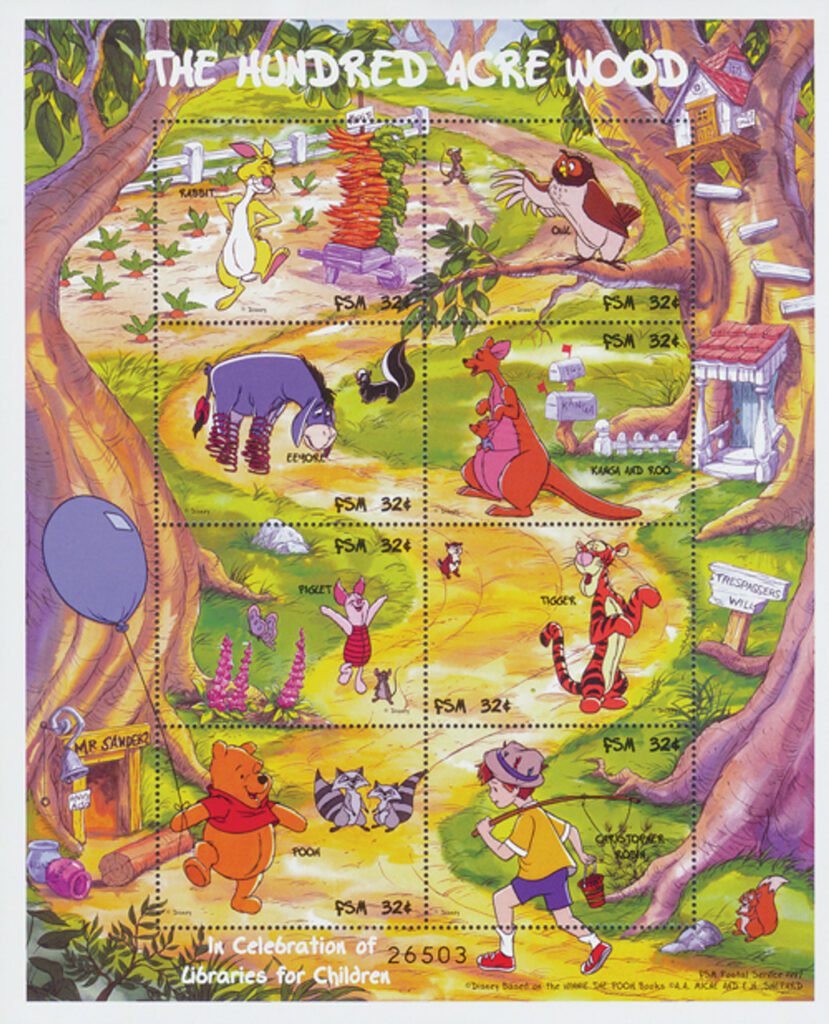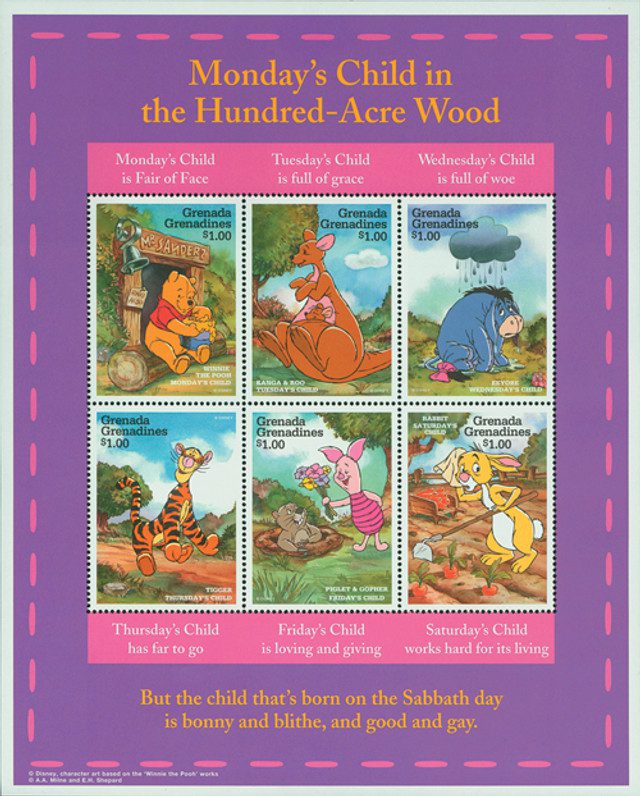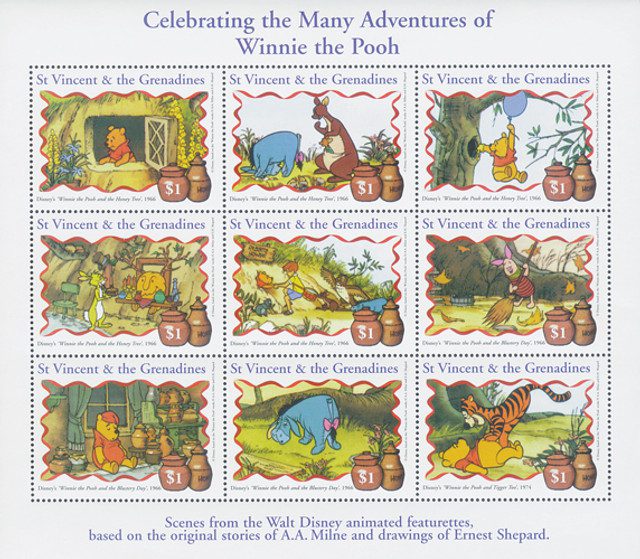On October 14, 1926, A.A. Milne published the first collection of Winnie-the-Pooh stories.
The legend of Winnie the Pooh began in 1921, when young Christopher Robin Milne received a stuffed bear for his first birthday. When he got older, Christopher changed the bear’s name from Edward to Winnie the Pooh.
Christopher named him after two of his favorite real-life animals, a swan called Pooh and a black bear at the London Zoo named Winnie. Canadian Lieutenant Harry Coleburn, who donated her to the zoo while he served in World War I, previously owned Winnie, named for Winnipeg, Manitoba. Christopher made frequent trips to the zoo to visit the friendly and playful black bear.
Christopher’s father, A.A. Milne, would entertain the boy for hours with stories and drawings of his beloved Winnie. Over time, Milne’s stories became more and more elaborate. The setting of the stories was based on Sussex, England’s Ashdown Forest, and the Hundred Acre Wood was based on Five Hundred Acre Wood.
Soon, Milne realized other children might be entertained by his stories. On February 13, 1924, he published the poem “Teddy Bear” in the magazine Punch. Later that year, the poem appeared in Milne’s book of children’s verse, When We Were Very Young. Then, in 1925, Milne published the first story that called Winnie-the-Pooh by name in a special Christmas piece in The Evening News.
Response to the story was so strong, Milne decided to publish his tales in book form. His first book, Winnie-the-Pooh, was published on October 14, 1926, which is generally considered to be the character’s birthday. The Christmas story from The Evening News was included in the book’s first chapter. The stories included Pooh’s friends, Piglet, a toy pig, Eeyore, a toy donkey, Owl, a live owl, and Rabbit, a live rabbit. Toys Kanga and Roo were introduced later in the book. And Tigger wasn’t introduced until the sequel, The House at Pooh Corner in 1928. E. H. Shepard illustrated Milne’s stories.
In 1930, Milne sold the merchandising rights for Winnie-the-Pooh to Stephen Slesinger. By the end of 1931, Pooh was making him $50 million a year. The following year, Pooh made his color debut, first appearing in the red shirt we all recognize. For over 30 years, Slesinger created the first Pooh doll, records, board games, puzzles, radio broadcasts, animations, and motion picture film.
After Slesinger died in 1953, his wife continued to develop Winnie-the-Pooh. Then in 1961, she licensed the rights to Walt Disney. The Disney studio began producing short films in 1966 featuring Winnie the Pooh, beginning with Winnie the Pooh and the Honey Tree, followed by Winnie the Pooh and the Blustery Day in 1968, and Winnie the Pooh and Tigger Too in 1974. These three films were combined under the name The Adventures of Winnie the Pooh in 1977. Pooh was so popular, the studio produced Winnie the Pooh and a Day for Eeyore in 1983.
Winnie the Pooh stories, always popular children’s literature, were introduced to millions more because of Disney’s animation. Both the books and movies remain enormously popular to this day, readily proven by the abundance of Winnie the Pooh products available. It’s a testimony to the charming stories and illustrations by A.A. Milne.
Pooh’s popularity is also a testimony to illustrator E.H. Shepard, who ably gave life to Milne’s characters without losing any of their original whimsy. The Pooh cartoons, each under thirty minutes in length, were some of the most charming and amusing cartoons made by Disney Studios.
Disney, of course, introduced his own touch to the first Milne story. As a boy, Walt had always wondered how Rabbit felt about Pooh’s bottom hanging into the middle of his wall. So when he decided to animate the story, he humorously explored this situation from Rabbit’s perspective, giving the story further depth. Another added touch was the use of musical instruments to announce the appearance of the characters on film. For example, a baritone horn introduced Pooh, a trumpet played for Christopher Robin, and a clarinet for Rabbit.
The game of Poohsticks, introduced in Winnie the Pooh and a Day for Eeyore, was based on a game created by A. A. Milne and Christopher Robin. In the game, each person drops a stick over a bridge and the person whose stick appears on the other side of the bridge first, wins. The game became so popular that the World Championship of Poohsticks race is held every year in Oxfordshire.
Winnie the Pooh is such a popular character around the world that there are even a couple streets named after him – one in Warsaw, Poland, and another in Budapest, Hungary.
Click here to see the original toys that inspired the Winnie-the-Pooh stories and here for more Winnie-the-Pooh stamps.
Click here to see what else happened on This Day in History.






my favorite childhood stories!
It is so nice to look back especially when kids enjoyed these stuffed animals. Those were the
happy days, not so much today. With stupid computers where hackers make it hard to do with
them. I appreciate the stamps you show and I pass them on to teachers to tell them this is a nice
way for kids to have a hobby and save money at the same time. thanks for sending them Audre
Thank you, Mystic. Pooh is an affectionate story and it is always around my house because it is an affectionate name my wife and sister call each other.
These are the kinds of stories that children should grow up with.
Great article.
Meant to remark earlier. Are there no U.S. stamps commemorating Winnie the Pooh?
I never heard of this cartoon character when I was a preteen (1940’s to 1950’s). I guess it is OK and I think my youngest girl–now 44–saw it a bit but it had little connection to the inner city/ghetto-like upbringing my kids got so I have little opinion to offer except when I first discovered it while working at the public library from age 14 to 18 I thought it had to do with going #2 (the poo get it?). Like a book for potty training we have available now. I laughed at myself then, but I guess it was not very cross cultural in those days so I just paid little attention until I saw my grandchildren watching shows with Winnie on TV in the 1970’s. They were amused, which makes sense as they are living a middle class upbringing. Interesting isn’t it how times change perception?